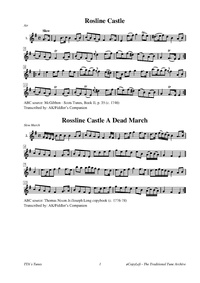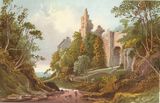Template:Pagina principale/Vetrina: Difference between revisions
No edit summary |
No edit summary |
||
| Line 14: | Line 14: | ||
|f_article=[[Roslin_Castle | '''Roslin Castle''']] | |f_article=[[Roslin_Castle | '''Roslin Castle''']] | ||
Rosyln Castle [2] does in fact exist in Angus, Scotland, and has since the early 14th century (c. 1304), when it was built by Sir William St. Clair soon after the Battle of Rosslyn, when, as part of the Scottish War of Independence, the English army of Edward I was decimated by the Scots. | |||
It is a castle of the rock and waterfall, lying high above the north bank of the River Esk a few miles south-west of Edinburgh, and features a small but magnificent chapel founded in 1446 by the Earl of Orkney and Roslin. | |||
Added to through the years, it survived two fires but was ultimately destroyed by Cromwell's troops in 1650. The heyday of the edifice was in the 14th and 15th centuries, where it has been likened to a 'Camelot' of the era. | |||
Neil (1991) remarks "It is on record that one of the princesses of the castle had 75 ladies-in-waiting and 53 of them were also members of the nobility, all of whom were beautifully dressed in gowns of velvet and silk and who also wore gold and other jewels. | |||
When this princess traveled to her house in Edinburgh, she was accompanied by 200 men on horseback and, if at night, by a further 80 carrying torches. | |||
There is also the legend that the castle is haunted by the "Sleeping Lady" who guards a vast treasure. If awakened by the sound of a trumpet, to be heard in the lower apartments, she will appear and reveal the treasure, whereupon the castle would rise from its ruins to its former glory." | |||
}} | }} | ||
Revision as of 07:22, 13 August 2023

Played by: Rob MacKillop
Source: Soundcloud
Image: Roslin Castle, Midlothian.

Rosyln Castle [2] does in fact exist in Angus, Scotland, and has since the early 14th century (c. 1304), when it was built by Sir William St. Clair soon after the Battle of Rosslyn, when, as part of the Scottish War of Independence, the English army of Edward I was decimated by the Scots.
It is a castle of the rock and waterfall, lying high above the north bank of the River Esk a few miles south-west of Edinburgh, and features a small but magnificent chapel founded in 1446 by the Earl of Orkney and Roslin.
Added to through the years, it survived two fires but was ultimately destroyed by Cromwell's troops in 1650. The heyday of the edifice was in the 14th and 15th centuries, where it has been likened to a 'Camelot' of the era.
Neil (1991) remarks "It is on record that one of the princesses of the castle had 75 ladies-in-waiting and 53 of them were also members of the nobility, all of whom were beautifully dressed in gowns of velvet and silk and who also wore gold and other jewels.
When this princess traveled to her house in Edinburgh, she was accompanied by 200 men on horseback and, if at night, by a further 80 carrying torches.
There is also the legend that the castle is haunted by the "Sleeping Lady" who guards a vast treasure. If awakened by the sound of a trumpet, to be heard in the lower apartments, she will appear and reveal the treasure, whereupon the castle would rise from its ruins to its former glory."
...more at: Roslin Castle - full Score(s) and Annotations
X:5 T:Rosline Castle,2voices. JGi.007 S:Joshua Gibbons MS,1823,Tealby,Lincs. M:C L:1/8 R:Air Q:1/4=90 O:Tealby,Lincolnshire Z:VMP/R.Greig, 2009 K:Dm V:1 clef=treble name="6." [V:1]|:F>E|D2 A>B A2G>A|{GA}BAGF E2F>E|D2d>e {de}f2e>d|cdec A2GA| [V:2]|:z2|z2FGF2EF|GFED ^C2z2|z2FGA2GF|E2A2A,2DE| [V:1]BAGF E2F>G|AFEDH^c2d>e|fde^c dA G/2B/2A/2G/2|F2 E>D D2:| [V:2]GFED C2DE|FDGFHA2FG|AFGD FD E2|A2A,2D2:| [V:1]A2|d^cde{de}f2e>d|a2gf e2d^c|dAde {ef}f2e>d|a>g f/2a/2g/2f/2 e2GA| [V:2]E2|F2FAd2A2|fed2FEz2|FEFAd2A2|fe d/2e/2f/2e/2A2EF| [V:1]BAGF E2FG|AFEDH^c2de|fde^c dA G/2B/2A/2G/2|F2 E>D D2:| [V:2]GFEDC2DE|FDGFHA2FG|AFGE FDE2|A2A,2D2:|
